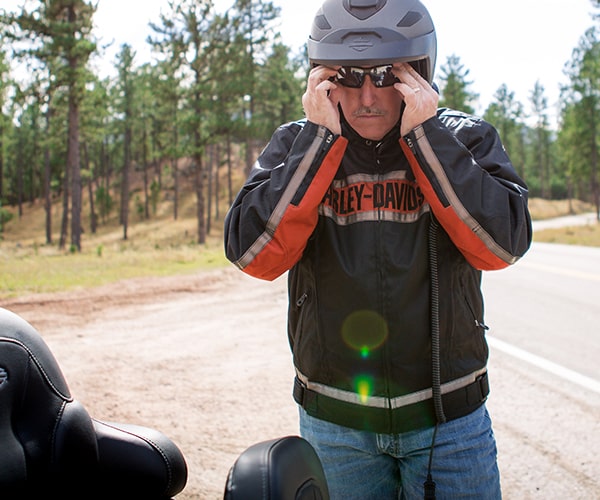Motorcycle Safety Feature: Eyewear
When it comes to motorcycle safety, keep your eyes on the prize. To do that, you’re going to need the right protective eyewear. And it turns out, there are several types and even more features to choose from. This guide gives you the rundown on what eyewear will best suit you and your riding style.
But before we dive in, let’s remind ourselves why eyewear is important. First of all, motorcycle eye protection is required by law in the state of South Dakota, so that right there screams important. Second of all, it’s just common sense. You’re hurtling down the road at 40, 50, 60+ miles per hour on nothing but two wheels and with only your gear to protect you. So make sure you’re wearing that gear. Proper eyewear will improve your vision in the sun, shield your eyes from wind and debris, prevent fatigue and protect your eyes in case of a crash. Oh, and third of all, what biker doesn’t look a bit cooler with some hardcore lenses on?
FRAME TYPE
To find the right eyewear for you, let’s start at the top. What type of helmet do you wear? If you sport a full face helmet (which we highly recommend), glasses will get the job done. Keep in mind plastic or nylon frames will offer more durability than metal frames do.
If you use an open face or half helmet, goggles should be your choice of frame because of the extra protection and security against wind or bumps. Whether you choose glasses or goggles, be sure they have a contoured bend that fits your head to cut down on the amount of air, debris and reflection that can come between the lenses and your eyes.
LENS TYPE
If you’re choosing between polycarbonate and glass lenses, definitely go with polycarbonate. Glass can shatter from impact or an oncoming object, which can result in glass shards stuck places glass shards shouldn’t be. Polycarbonate is shatterproof and will deflect unexpected objects. Also keep in mind the importance of optical quality. Buying the $5 pair of glasses at the gas station might seem good for the wallet, but they can cause vision fatigue and damage your eyesight. Less isn’t always more.
LENS FIXIN’S
Lenses have about as many fixin’ options as a Coney Island hotdog. Who knew? Luckily, you do now. Make sure to keep the below features in mind when shopping for your new specs.
Lens Fit
The bigger the better when it comes to lens size. Because the larger the lens, the more coverage your eyewear offers, protecting your retinas from the hazards of the road. The overall fit of your eyewear of choice should be comfortable but not too loose. The last thing you want to have to do while rolling down the highway is constantly push your glasses up your nose.
Lens Coatings
There are all types of lens coatings, but some are more important than others when you’re riding on two wheels. Before choosing your eyewear, be sure you’re familiar with these options:
- UV Protection: One of the most standard and important coatings protects your eyes from UV rays. Even if you’re wearing clear lenses, they should have UV protection.
- Scratch Resistant: So much as a small scratch is enough to cause eye strain and fatigue, so look for lenses with a scratch-resistant coating.
- Non-reflective: Reflections on the inside of your glasses can distract and strain your eyes. Avoid them with a non-reflective coating.
- Polarized: Greatly reduce glare and increase your visibility when riding in the sun with polarized glasses.
- Light Adjusting: Transitional lenses adjust the lens color to provide more shading in bright conditions and less during moments of low light. This can come in handy when you don’t have time to switch between your polarized and clear eyewear.
Lens Colors
Depending on the time of day, weather and road conditions, certain lens colors are better than others. A yellow or amber lens increases your depth perception during foggy and low-light conditions. Grey or smoke lenses provide the truest depiction of the actual light you’re seeing while still protecting your eyes from the sun. A clear lens is what you’ll need to legally ride your bike at night. They also come in handy in rainy situations when a tinted lens might make it difficult to see. Green, blue, brown, red…you can find a variety of lens colors available. These colors don’t necessarily serve a safety purpose, so if you’d rather see what’s on the road in true form, we’d suggest avoiding the rave-colored options.
With so many different lens colors for different occasions, it can seem like a lot to carry on your motorcycle with you. Multi-lens options might be the solution to that problem. They allow you to physically interchange lenses in glasses or goggles to fit your riding conditions and are often a cheaper alternative to transitional lenses.

